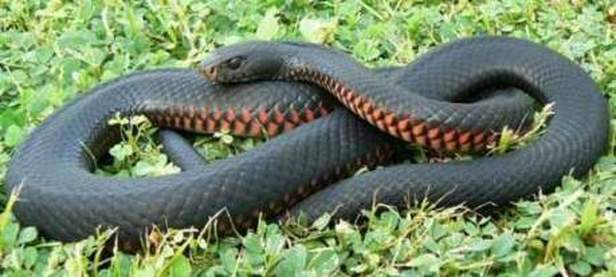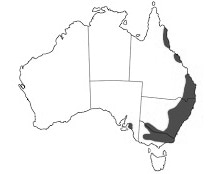Red-Bellied Black SnakePseudechis porphyriacus |

Custom Search
|
|
The red-bellied black snake (Pseudechis porphyriacus) is an elapid venomous snake species native to eastern Australia. The red-bellied black snakes are found in a more or less continuous range from southeastern Queensland south through eastern New South Wales and Victoria.
Other disjunct populations occur in northern and central eastern Queensland and in the south at the southern end of the Mount Lofty Ranges. They are commonly found in woodlands and forests usually in the close vicinity of water sources such as streams, rivers, creeks, seasonally inundated alluvial woodlands, lagoons, swamps and other wetlands. It is also common in urban areas along Australia's eastern coast and it has also adapted to live in modern rural environments being found close to irrigation canals and dams. For these reasons, it's one of Australia's best-known snake species. The red-belly black snake has an average length of 1.5 to 2 m, but some specimens may reach up to 2.5 m. These are some of Australia's largest venomous snakes. Contrary to most other snake species females are slightly smaller than males.
Like its common name implies the red-bellied black snake has a glossy black upper body color and a red, crimson or pinkish coloration on the belly extending to the lower sides. They are also known by other names such as common Black Snake or Red-belly.
These snakes seem to be territorial having several preferred shelters within their domain, they usually take shelter under logs, large rocks, inside animal burrows and within clumps of grass. They red-bellied black snake may be active both during the day and at night. The red-bellied black snake isn't considered a very aggressive species and will try to escape if given the opportunity, but if provoked it recoils into a striking stance flatten the neck and hissing as a threat display. Subspecies There are no subspecies recognized. Venom / Bite The red-bellied black snake is one of the most frequently encountered snakes on Australia's east coast and they are responsible for several bites every year. Like all other elapid snakes, it has the fangs in the front of the mouth, although they are relatively small. Even though the red-bellied black snake is venomous a bite from one is rarely life-threatening, unlike a bite of a taipan snake or the infamous death adder. These snakes usually inject little venom, but still, immediate medical attention should be given to any bite from a venomous snake. Their venom consists of several components including mycotoxins, neurotoxins, coagulants and it also has some hemolytic properties. The bite causes some local symptoms such as bleeding and swelling at the bite site. But also other general symptoms including general weakness, nausea, vomiting and headache, diarrhea, and muscle pain. Because of the cytotoxins found in its venom, which cause muscle damage the victim may also pass reddish or brown urine as a result of the bite. Sometimes bite victims will lose the sense of smell. There are no records of any human fatality from a Red Bellied Black Snake bite. Although black snake antivenom is available usually doctors will use tiger snake antivenom instead, because it's cheaper and a lower dose is needed making it less likely to cause any adverse reaction in the victim. Diet / Feeding
The red-bellied black snake feeds primarily on frogs and tadpoles. But these snakes also prey on other reptiles such as lizards, birds, fish, eggs, and small mammals. Their particular diet makes them especially vulnerable to the poisonous Cane Toad. They also eat other snakes such as the highly venomous eastern brown, but also those of their own species. They search actively for prey both on land and in water and are known to climb trees several meters high. When they forage in water they may even submerge completely in search of prey. On occasion, they've been observed trying to flush out hidden prey by stirring up the underwater sediment. If they manage to capture a prey it may swallow it while the red-bellied black snake is still under water or may be brought to the surface. Reproduction The mating season occurs in the spring. Rival males will "combat" with each other, intertwining their bodies and raising their heads in an attempt to place it higher than that of their rival. Unlike other close relatives the Red-bellied black snake is ovoviviparous, females give birth to live young they don't lay eggs. Pregnant females are known to congregate to bask in the sun together. The babies develop inside the mother body and are born in thin individual transparent membrane sacs, which they easily tear very shortly after birth by wriggling to free themselves. The young snakes are born in mid-summer to early autumn, between January and March. The litter size ranges anywhere from 8 to 40 younglings, which at birth are about 12 cm (5 inches) in length. Conservation / Threats The red-bellied black snake has not yet been assessed for the IUCN Red List. In some locations, the red-bellied black snake was almost driven to extinction because of the introduced poisonous Cane Toad. When a snake tried to eat a cane toad they often died from poisoning because of the poisonous toxins present in their skin and glands. But it appears that these snakes have learned to avoid the Cane Toad and their population number are recovering.
|
Scientific classification |
© 2014 Snake Facts About Us | Privacy Policy | Contact





